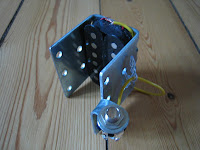
As described in an
earlier post, I've tried to make a compact set of coarse tuners to go with the fine tuners on my
Schaller 456 fine tuning bridge, so I could reduce the headstock and loose the big and heavy traditional tuners. The earlier attempt in the form of a locking nut wasn't succesful, but now I think I'm on to something.
I've installed my own coarse tuners, each consisting of a blind screw, a T-nut and an allen nut (a.k.a. an internal wrenching nut). In the blind screw, a hole is drilled for the string to go through, just like the peg of an ordinary tuner.

To tune up the guitar, you turn the blind screw clockwise with an allen key until you reach the approximate tone. Then you fasten it by tightening the allen nut on the back of the headstock. The rest of the tuning is done with the fine tuner at the bridge.
One of the beautiful things about it is that when you tighten or loosen the string by turning the set screw, the height of the string over the fingerborad stays the same, since it rests in the screw's thread. And the pull of the string tightens the allen nut against the T-nut, securing the string even more.
The best thing about it is, it seems to work perfectly. And it's much smaller and lighter than ordinary tuners, so it's a good solution if you want to build a headless guitar - or convert an existing guitar to one. You'll have to leave a little bit of headstock for the T-nuts, but that's not much. And you might want it anyway to stop your fretting hand from sliding off the neck.

On my own guitar I've mounted the tuners on the very end of the headstock. The reason is that I'll be using the other sections of the headstock for experimentation with alternatives to the T-nuts. A set of threaded inserts and a brass plate with threaded holes are some of the things I want to try. Next experiment will probably be threaded inserts mounted on the next section of the headstock. And I imagine that when I have reached the last section of the headstock, next to the nut, I'll know which of the solutions I prefer.
Drilling the string holes in the blind screws was a pain. I only got two made before I had dulled or broken my drill bits. I'll have to buy some new ones and do it right. That's the reason why the remaining four strings in the picture go to traditional tuners.
Btw, I imagine that if you add some loctite or similar to increase friction, you might be able to do away with the allen nut. Afaik, there also is a substance called "peg dope". I have to get some and try if the tuner can hold the string without the allen nut.
 Since everything - restringing, tuning and playing - worked fine with the latest version of the coarse tuners, I decided (as mentioned in this post) to keep this layout and cut off the remaining headstock. The shape it has now might be altered slightly - I'm not quite sure about that. I have to paint the headstock black where I've cut and sanded it, but apart from that, I am just going to play it for some time and not alter anything (or not much, at least).
Since everything - restringing, tuning and playing - worked fine with the latest version of the coarse tuners, I decided (as mentioned in this post) to keep this layout and cut off the remaining headstock. The shape it has now might be altered slightly - I'm not quite sure about that. I have to paint the headstock black where I've cut and sanded it, but apart from that, I am just going to play it for some time and not alter anything (or not much, at least).
































